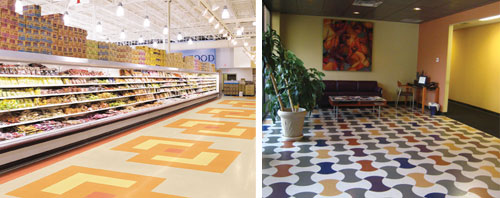Assessing Resilient Flooring for Sustainability: Introducing a New Standard
Understanding NSF/ANSI Standard 332
From the outset, the intent was to develop a comprehensive standard that looked at multiple criteria so that products could be assessed based on multiple attributes of that product, not just a single attribute. Single-attribute standards serve a purpose but multi-attribute standards are regarded as more indicative of determining such things as an Environmentally Preferable Product (EPP) as mandated by many government agencies. NSF 332, which uses the multi-attribute approach, is responsive to market requests for a more comprehensive tool just as FloorScore® responded to market demands for measuring VOC emissions which impact indoor air quality.
Criteria Category Groupings
Six categories of potential environmental impact to be evaluated are included in NSF 332. The criteria are grouped in general conformance with a product's life cycle, from design (including raw material selection and their production) to manufacturing, use and end of life. Additionally, criteria related to corporate governance are included to address issues of social responsibility. The six categories are as follows:
- Product design that encourages manufacturers to integrate environmental and life-cycle thinking into the product's design process
- Product manufacturing processes that encourages manufacturers to quantify the environmental impacts from their manufacturing, and then act to reduce or remove those impacts
- Long-term value encouraging manufacturers to maximize product longevity
- End-of-life management encouraging existing and new resilient flooring products to be collected, processed, recycled, and/or composted within the existing material's recycling infrastructure
- Corporate governance encouraging corporate social responsibility in the form of providing a desirable workplace, being involved in the local community, and demonstrating financial health
- Innovation (optional) to give manufacturers the opportunity to be awarded points for exceptional performance above the requirements set forth in NSF 332
Scoring MethodologyFor resilient flooring manufacturers that choose to assess the sustainability performance of their products in accordance with this standard, a point-based scoring system has been developed. The system is based on a 90-point scale with a varying number of points assigned to accomplishing each of the assessment categories. Note that the Innovation category is optional and allows for 10 bonus points beyond the 90 available in the other categories for a total maximum potential score of up to 100 points. The category point breakdown is as follows:
- Product Design – up to 30 points
- Product Manufacturing – up to 29 points
- Long-Term Value – up to 9 points
- End-of-Life Management – up to 10 points
- Corporate Governance – up to 12 points
- Innovation – up to 10 points
Labeling, Reporting and Certification
The methodology for assessing whether a product conforms to the environmental and social responsibility criteria and for verifying ongoing conformance begins with the manufacturer. Each manufacturer self-certifying under NSF 332 is responsible for creating appropriate documentation in sufficient detail to ensure confidence that the requirements in the standard have been met. Product manufacturers making a declaration of conformance with the standard (i.e. a substantiated claim of sustainability for the product(s) assessed) should report this in a publicly available document (e.g., available on manufacturer's website).
Achievement of conformance with all of the prerequisites and additional criteria allows manufacturers to declare Sustainable Product(s) Achievement declarations based on the specific point score achieved for each individual product assessed as follows:
Conformant: 25 points minimum
Silver: 35 points minimum
Gold: 45 points minimum
Platinum: 60 points minimum
When architects are preparing specifications for sustainable resilient floor coverings, the NSF/ANSI Standard 332-2010 can be identified at the Conformant level (25 points) as a minimum. For buildings and designs seeking higher levels of sustainability, Silver, Gold or Platinum levels can be specified. Note that the availability of manufacturer's products at those levels must be determined for a coordinated design. It is also important to note that these levels of sustainability can be specified independently of any other sustainability goals for the project such as LEED certification through the U.S. Green Building Council and GREEN GLOBES green building certification. This approach using defined levels of conformance was developed so that sustainability principals could be attainable by companies regardless of size or number of manufacturing plants. Note, however, that certification is for specific products made at specific plants. The same product made at a different plant which is not part of the certification process cannot bear the standard's certification.
 |
Prerequisites within the NSF/ANSI Standard 332-2010 must be met, along with optional sustainability criteria, for resilient flooring to achieve one of four levels of Sustainable Product Achievement. Photos courtesy of Resilient Floor Covering Institute |









